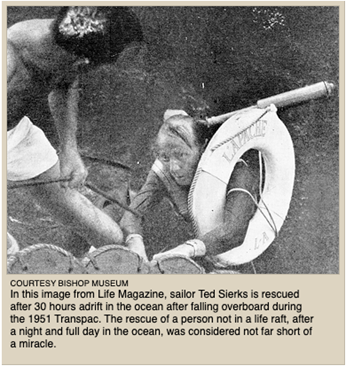Overboard in Warm Water
Overboard in Warm Water
“Safety Moments, presented at CCA Stations and Posts”
By Chuck Hawley, San Francisco Station, December 7, 2022
In addition to stories about the increased cost of turkeys, the miserable weather in Buffalo NY, and the crash of at least one crypto company, a remarkable story about a man overboard incident was reported on Thanksgiving. A passenger on a Carnival Cruise Ship, traveling from New Orleans to Cozumel, was reported missing about 13 hours after he was last seen onboard. A search ensued, and the passenger was spotted by a commercial vessel, which then relayed the coordinates to the Coast Guard. He was picked up by a Coast Guard MH-60J shortly thereafter, apparently hypothermic, and was transferred to a local hospital where he was reportedly recovering. It’s not known how he ended up in the water, but credit for his lengthy survival was given to the 70℉ water temperature and the swimmer’s “will to survive.” It’s not known what he was wearing, but he did not appear to have had any sort of flotation, nor did he have clothing or devices that would insulate him from the Gulf water.
|
L’Apache, as shown in the 1951 Transpac Race Program. |
While 15 hours in the water is long by anyone’s standards, there’s another example of a survival by a sailor that is even more remarkable. During the 1951 Transpacific Yacht Race to Hawaii, a sailor named Ted Sierks fell overboard from the vessel L’Apache, about 800NM from Hawaii. Sierks was an ex-marine and a photographer, and he had gone aft to repair a “boom tackle” on the 72’ vessel. While leaning against the stern railing, it gave way, and he fell into the Pacific without the benefit of a life jacket. The crew was able to throw a life ring, equipped with a knife and a flashlight, in his direction. They dropped the spinnaker and began a day-long search but were unable to find their crewman. Dejectedly, they sailed on to Honolulu.
Hearing of the incident by radio, the Navy sent a veritable flotilla to help in the search, including a “an escort carrier, four destroyers, three destroyer escorts”. In addition, a B-17 from Hickam Air Field joined in the search. During his time in the water, Sierks was forced to defend himself from sharks on two occasions. After over 30 hours in the water, the Navy destroyer, Douglas A Munro, spotted Mr. Sierks and rescued him, eventually delivering him to Honolulu. As an incentive, the captain of the destroyer had apparently offered a $50 bounty for the first sailor to spot Mr. Sierks.

From what we can determine from ncei.noaa.gov, the water temperature during Mr. Sierks’s swim would have been between 77 and 80℉[1], or what we’d expect from a recreational pool. According to the US SAR Task Force, in 70-80℉ water, time to exhaustion or unconsciousness is 3-12 hours, and expected survival time is 3 hours to “indefinitely”. So, while his actual survival time of 30 hours falls within the limits of “indefinitely”, we can conclude that Mr. Sierks was a very lucky man.
So we have two different overboard incidents, 71 years apart, under different circumstances yet with similar outcomes. Swimmers who can avoid exhaustion, in relatively calm water, can survive for surprisingly long periods of time. Having an appropriate life jacket, or really any life jacket, can reduce one’s heat loss by allowing the swimmer to be more passive and increase the time available for rescue.
The Cruising Club of America is a collection of accomplished ocean sailors having extensive boat handling, seamanship, and command experience honed over many years. “Safety Moments” are written by the Club’s Safety Officers from CCA Stations across North America and Bermuda, as well as CCA members at large. They are published by the CCA Safety and Seamanship Committee and are intended to advance seamanship and safety by highlighting new technologies, suggestions for safe operation and reports of maritime disasters around the world.
[1] One account in the 1953 Transpac race program puts the temperature at 85℉, but I can’t find additional support for what appears to be a very high sea temperature. https://www.ussailing.org/wp-content/uploads/2018/01/Lifesling-Case-History.pdf







